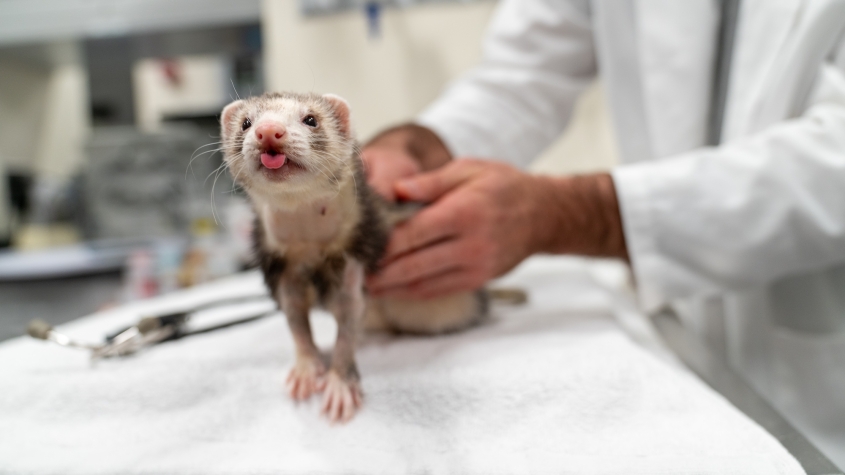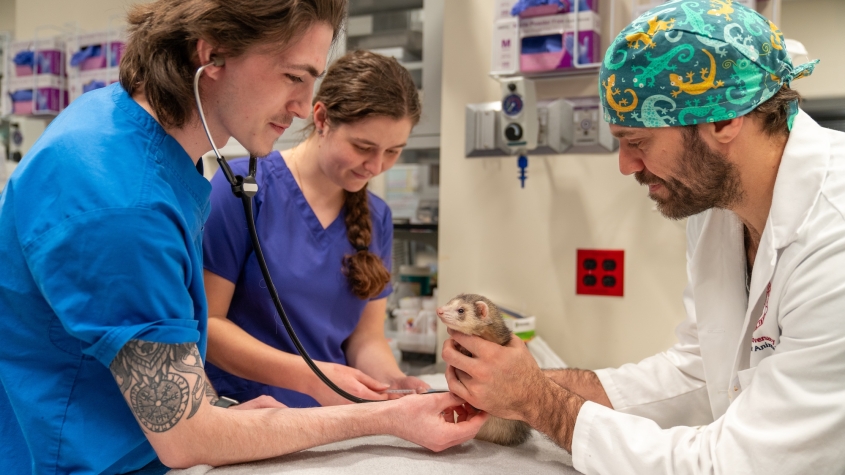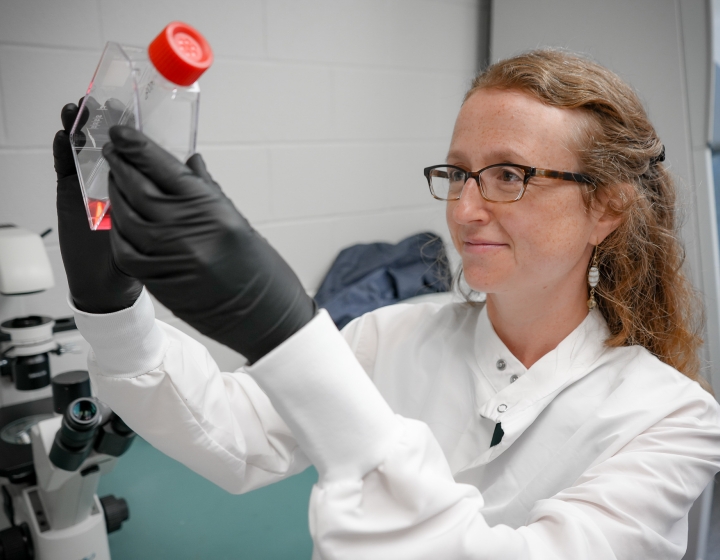Fig the ferret fights off lymphoma
Fig is a firecracker, a three-year-old ferret with boundless energy. His owner, Brittany Ray, describes him as a “sour patch kid — first sour, then sweet, but mostly sweet. He’ll nip at your feet and then cuddle in your lap.”
So when Fig was suddenly lethargic and wouldn’t eat one day, Ray knew something was amiss and rushed him to the Cornell University Hospital for Animals.
“We ordered an abdominal ultrasound stat, and radiologists looking at Fig’s intestinal tract quickly realized that he had a perforated intestine,” said Dr. Nicola Di Girolamo, associate professor and section chief of exotics. “This was as much of an emergency as there can be.”
Ray agreed to bring Fig immediately into surgery, where Di Girolamo, with exotics intern Dr. Adam Moreno and then-veterinary student Kendall Peterkin, D.V.M. ’24, removed a large portion of his intestinal tract.
Later, Cornell pathologists confirmed he had lymphoma, and a tumor had caused the perforation.
“Not only did Fig need the section of his intestines that contained the rupture removed, but also the tumor, followed by sewing the intestines back together, one cut end to another,” said Dr. Lauren Thielen, assistant clinical professor in the exotics section and a member of Fig’s care team.
With Fig’s small size — approximately 2 pounds — this surgery was a challenge. It went well, however, and Ray decided to pursue chemotherapy for Fig to remove the rest of the lymphoma.
Fig’s diagnosis was intermediate-grade, large-cell, alimentary lymphoma. Lymphoma is a common cancer in ferrets and can happen at any age. The clinical signs range from gastrointestinal issues to enlarged lymph nodes, spleen and liver. With early diagnosis, there are reasonable treatment options that can improve the life of the ferret.
Chemotherapy in ferrets
Chemotherapy is used to address cancer where it remains in the body, waiting to cause more issues. It’s helpful in preventing cancer regrowth at the surgical site as well, Thielen notes. Collaboration with the oncology service was essential.
For the next several months, Ray commuted back and forth from Fulton, New York, on Fig’s chemotherapy appointment days. “Fig is always mostly alert and very playful when he gets home,” Ray said. “I’m so proud of him. He’s been resilient and is such a tough little guy.”
Chemotherapy in ferrets requires certain species-specific considerations. While the medications used to treat other animals are similar — a rotation of different drugs so the cancer doesn’t have a chance to build resistance — the ability to actually give these medications is challenging because of Fig’s small veins.
“The catheter placement has to be perfect, because if any chemotherapy leaks from the vein under his skin, a reaction can occur,” Thielen said.
Even oral drugs can be complicated, as Fig is so small that many of them needed to be compounded into liquids. “We were able to work with our oncology team, and use research published by other veterinarians treating ferrets with chemotherapy, to come up with a plan that avoided exclusively relying on intravenous drugs, which could be extremely dangerous if they leaked from the vein, and combine it with some oral or even under-the-skin injections to balance out Fig’s treatment protocol,” Thielen said.
Moreover, certain medications lowered Fig’s white blood cell count and predisposed him to infection. Such side effects delayed his chemotherapy treatments and made his cancer journey trickier.
Fortunately, the veterinarians’ efforts paid off, and Fig responded well to treatment. He is now officially in remission.
Back to his old self
Ray is used to a house full of lively pets. Fig has lived with other ferrets, a dog and four cats. He’s now back to his confident and energetic self.
“He loves to play and explore and will greet any creature with almost no apprehension,” Ray said. “Like most ferrets, he’s a very big thief. He’ll steal anything and hide it under the furniture.”
For now, Fig is working on growing the hair back that the Cornell veterinarians shaved. “We’ve nicknamed him Patches,” Ray joked. They’ll continue with bloodwork and monitor the size of his lymph nodes. “Fig is free to live life as a regular ferret — sleeping for 18-20 hours a day and raging for the rest.”
“We love Fig,” Thielen said. “We’re hopeful for his good prognosis. He has a recheck ultrasound to look for the cancer in three months just to ensure all is okay.”
“I have just been so impressed with the level of care and compassion the whole exotics team, but especially Dr. Di Girolamo and Dr. Thielen, has shown Fig,” Ray said. “I truly believe they love him and have advocated and fought for him. I can’t thank them all enough.”
Written by Melanie Greaver Cordova









